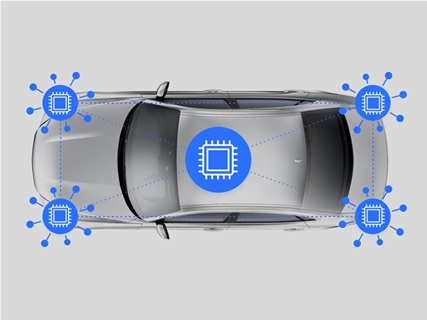Zonal Architectures Are Reshaping Vehicle Design. Are You Ready?

The automotive industry is undergoing a seismic shift, and it's not just about electric drivetrains or autonomous features. The real revolution is happening under the hood—literally—with the adoption of zonal architectures and 48V systems. This is a necessary evolution—today’s EVs, hybrids, and advanced internal combustion vehicles draw more electrical power than ever before due to ADAS, active suspension, infotainment, and cooling systems and EV manufacturers need to be proactive in rising to the design challenges of tomorrow to stay competitive in a rapidly evolving market.
What Is Zonal Architecture?
Traditional vehicles rely on a distributed electrical/electronic (E/E) architecture, where numerous electronic control units (ECUs) are scattered throughout the vehicle, each handling specific functions. This setup leads to complex wiring harnesses, increased weight, and higher production costs.
Zonal architecture flips this model by dividing the vehicle into distinct zones—front, rear, left, right—each managed by a central zone controller. These controllers handle localized functions and communicate with a central computing unit. The benefits are substantial:
- Reduced Complexity: Fewer ECUs and simplified wiring reduce potential failure points.
- Cost Savings: Simplified design and manufacturing cut down on expenses.
- Enhanced Scalability: Easier to implement across different vehicle models and platforms.
Companies like Rivian and Volkswagen are already leveraging zonal architectures to streamline their vehicle designs and improve system reliability.
Why 48V matters for EVs and hybrids:
Parallel to the shift in E/E architecture is the move from traditional 12V systems to 48V systems. This change helps to address the growing power demands of modern vehicles.
- Supports mild hybrid powertrains: Enables start-stop, regenerative braking, and low-speed electric driving without full high-voltage systems.
- Critical for thermal management: 48V motors are ideal for driving pumps and fans in battery cooling and HVAC systems.
- Scales with innovation: Future-ready for increased electrification without the cost and complexity of 400V+ high-voltage systems.
Tesla’s decision to move to 48V in the Cybertruck sends a clear signal: this isn’t experimental, it’s essential.
EV System Integration Challenges and What to Expect
Implementing zonal architecture and 48V systems in electric or hybrid vehicles isn’t plug-and-play. It introduces new challenges across engineering, supply chain, and system design, including:
- Higher upfront development costs for hardware and architecture redesign.
- Supplier realignment for new ECUs, connectors, and power electronics.
- Thermal and power management at the zone level becomes more complex and critical.
- Requires deep expertise in EV system integration, from motor control to thermal management systems.
Regardless of the challenges, this is where the future is heading. Companies that solve these issues early will have an edge over the competition.
Where Zonal Architecture and 48V Systems Converge
The intersection of zonal architecture and 48V systems is where the next wave of electric vehicle innovation happens. Combining zonal architecture with 48V systems creates a synergistic effect that amplifies the advantages of each, including:
- Optimized Power Distribution: Localized control allows for efficient power management tailored to each zone's needs.
- Smaller, lighter harnesses across the EV platform with fewer modules and wiring, resulting in lighter, more efficient vehicles with improved range and performance.
- Future-proof platforms that support OTA updates, system upgrades, and new feature integration, making it easier to incorporate new technologies without a ground-up redesign.
- Scalability: Facilitates the development of modular platforms adaptable to various vehicle types and configurations.
The Takeaway
Automotive zonal architecture and 48V automotive systems are redefining electric vehicle design from the ground up. They enable smarter, more modular electric vehicle powertrains, more efficient thermal management systems, and scalable EV architectures that will power the next generation of hybrid and electric vehicles.
This is not just a trend, it’s the next industry standard. If you're not already building toward it, you're falling behind. The road ahead is clear, and it's time to take the wheel. To learn more, check out our 48V Systems page.